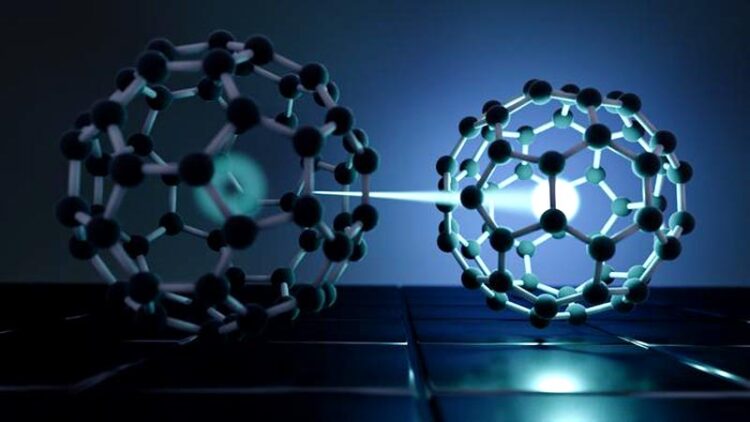Spectroscopy and theory shed light on excitons in semiconductors

Illustration showing light exciting electrons in two molecules of the organic semiconductor known as buckminsterfullerene. The newly formed exciton (shown by the bright dot) is first distributed over two molecules before it settles on one molecule (shown on the right in the picture).
Credit: Andreas Windischbacher
Research team led by Göttingen University make extremely fast, precise images for first time.
From solar panels on our roofs to the new OLED TV screens, many everyday electronic devices simply wouldn’t work without the interaction between light and the materials that make up semiconductors. A new category of semiconductors is based on organic molecules, which largely consist of carbon, such as buckminsterfullerene. The way organic semiconductors work is largely determined by their behaviour in the first few moments after light excites electrons, forming “excitons” in the material. Researchers from the Universities of Göttingen, Graz, Kaiserslautern-Landau and Grenoble-Alpes have now, for the first time, made very fast and very precise images of these excitons – in fact, accurate to one quadrillionth of a second (0.000,000,000,000,001s) and one billionth of a metre (0.000,000,001m). This understanding is essential for developing more efficient materials with organic semiconductors. The results were published in Nature Communications.
When light hits a material, some electrons absorb the energy and this puts them into an excited state. In organic semiconductors, such as those used in OLEDs, the interaction between such excited electrons and left-over “holes” is very strong, and electrons and holes can no longer be described as individual particles. Instead, negatively charged electrons and positively charged holes combine to form pairs, known as excitons. Understanding the quantum mechanical properties of these excitons in organic semiconductors has long been considered a major challenge – both from a theoretical and an experimental point of view.
The new method sheds light on this puzzle. Wiebke Bennecke, physicist at the University of Göttingen and first author of the study, explains: “Using our photoemission electron microscope, we can recognise that the attractive forces within the excitons significantly change their energy and velocity distribution. We measure the changes with extremely high resolution in both time and space, and compare them with the theoretical predictions of quantum mechanics.” The researchers refer to this new technique as photoemission exciton tomography. The theory behind it was developed by a team led by Professor Peter Puschnig at the University of Graz.
This new technique enables scientists, for the first time, to both measure and visualise the quantum mechanical wave function of the excitons. Put simply, the wave function describes the state of an exciton and determines its probability of being present. Dr Matthijs Jansen, Göttingen University, explains the significance of the findings: “The organic semiconductor that we studied was buckminsterfullerene which consists of a spherical arrangement of 60 carbon atoms. The question was whether an exciton would always be located on a single molecule or whether it could be distributed across several molecules simultaneously. This property can have a major influence on the efficiency of semiconductors in solar cells.” Photoemission exciton tomography provides the answer: immediately after the exciton is generated by light, it is distributed over two or more molecules. However, within a few femtoseconds, meaning in a tiny fraction of a second, the exciton shrinks back down to a single molecule.
In future, the researchers want to record the behaviour of the excitons using the new method. According to Professor Stefan Mathias, Göttingen University, this holds potential: “For example, we want to see how the relative motion of molecules influences the dynamics of excitons in a material. These investigations will help us understand energy conversion processes in organic semiconductors. And we hope that this knowledge will contribute to the development of more efficient materials for solar cells.”
This research benefited from the German Research Foundation (DFG) funding for the Collaborative Research Centres “Atomic scale control of energy conversion” and “Mathematics of Experiment” in Göttingen and “Spin+X” in Kaiserslautern-Landau. The team in Graz was supported by funding from the ERC Synergy Grant “Orbital Cinema” of the European Union.
Original publication: Bennecke, W. et al. Disentangling the multiorbital contributions of excitons by photoemission exciton tomography. Nature Communications (2024). DOI: 10.1038/s41467-024-45973-x
Contact:
Professor Stefan Mathias
University of Göttingen
Faculty of Physics
Friedrich Hund Platz 1, 37077 Göttingen, Germany
Tel: +49 (0)551 39-27601
Email: smathias@uni-goettingen.de
www.mathiaslab.uni-goettingen.de
Dr G S Matthijs Jansen
University of Göttingen
Faculty of Physics
Email: gsmjansen@uni-goettingen.de
Professor Peter Puschnig
University of Graz
Institute of Physics
University Square 5, 8010 Graz, Austria
Tel: +43 (316) 380 5230
Email: peter.puschnig@uni-graz.at
www.homepage.uni-graz.at/en/peter.puschnig
Journal: Nature Communications
DOI: 10.1038/s41467-024-45973-x
Method of Research: Experimental study
Subject of Research: Not applicable
Article Title: Disentangling the multiorbital contributions of excitons by photoemission exciton tomography
Article Publication Date: 28-Feb-2024
Media Contact
Melissa Sollich
University of Göttingen
melissa.sollich@uni-goettingen.de
Office: 49-551-392-6228
Original Source
Media Contact
All latest news from the category: Physics and Astronomy
This area deals with the fundamental laws and building blocks of nature and how they interact, the properties and the behavior of matter, and research into space and time and their structures.
innovations-report provides in-depth reports and articles on subjects such as astrophysics, laser technologies, nuclear, quantum, particle and solid-state physics, nanotechnologies, planetary research and findings (Mars, Venus) and developments related to the Hubble Telescope.
Newest articles

First-of-its-kind study uses remote sensing to monitor plastic debris in rivers and lakes
Remote sensing creates a cost-effective solution to monitoring plastic pollution. A first-of-its-kind study from researchers at the University of Minnesota Twin Cities shows how remote sensing can help monitor and…

Laser-based artificial neuron mimics nerve cell functions at lightning speed
With a processing speed a billion times faster than nature, chip-based laser neuron could help advance AI tasks such as pattern recognition and sequence prediction. Researchers have developed a laser-based…

Optimising the processing of plastic waste
Just one look in the yellow bin reveals a colourful jumble of different types of plastic. However, the purer and more uniform plastic waste is, the easier it is to…


